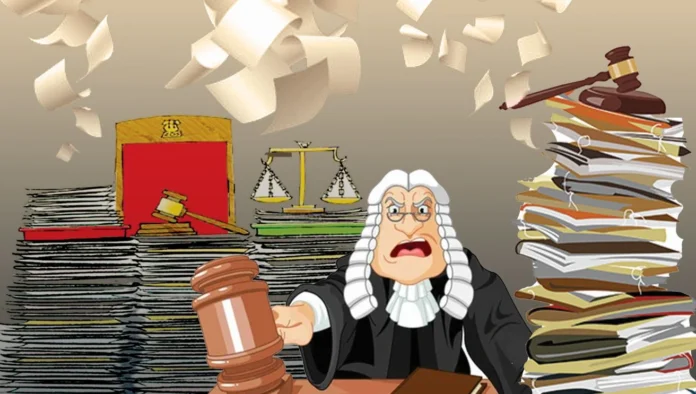By Dilip Bobb
Last week, the Union Law Ministry provided the latest pendency statistics in all courts in India—and they were shocking. Over five crore cases are pending at various levels. This huge backlog slows down justice delivery, affecting governance, economic growth, and human rights.
The issue of cases pending in India’s judicial system is endemic and long-standing, but some statistics stand out for their sheer incomprehensibility. Justice delayed is justice denied, as the old saying goes, but here’s the brutal fact: the latest figures include 62,000 cases pending in various High Courts for more than 30 years—and three of them date back to 1952. These accused or prisoners would have completed their sentences even if given the harshest punishment short of a death sentence.
Section 55 of the IPC says that life imprisonment can be remitted to as low as 14 years by the “appropriate government”, while Section 57 deems life imprisonment to be 20 years except in the most heinous crimes.
The latest figures, read out in the Rajya Sabha by Law Minister Arjun Ram Meghwal in response to a question, contained another appalling statistic: the Calcutta High Court tops the list for cases pending over 50 years, with 2,185 such cases—a staggering 94 percent of the 2,329 total. Alarmingly, since last year, the Calcutta High Court has added 140 more such cases to the list.
That’s not all. There are 22,829 cases pending between 40 and 50 years at 25 High Courts, 63,239 pending for 30 to 40 years, over 3.4 lakh cases pending for 20 to 30 years, and 11.5 lakh pending for 10 to 20 years. The oldest case is 74 years old. The Madras High Court comes second in the 50-year-plus category with 56 such cases, followed by Patna (46) and Allahabad (17) High Courts. Most other High Courts have such cases in single digits, with Telangana (nine), Orissa (eight), Madhya Pradesh (four), and Bombay and Punjab and Haryana with two each. At the district level, pendency is less extreme, but still alarming—1,113 cases pending for 50 years, with West Bengal again topping the list with 39 percent of such cases. This, despite the Supreme Court sending regular instructions to High Courts to clear 10-year-plus cases on priority.
THE MAIN ISSUES BEHIND PENDENCY
- Government as litigant: The centre and states are the biggest litigants, accounting for 50 percent of the pending cases, many of them frivolous.
- Property disputes: Land/property disputes account for 66 percent of all pending civil cases; 25 percent of Supreme Court cases involve land disputes.
- Vacancies: Shortage of judges in lower courts persists due to poor salaries and career prospects.
- Technology gaps: E-courts and AI-based case management have underperformed.
- Frivolous cases: From bizarre movie-related lawsuits to challenges against Darwin and Einstein, such cases still clog the system.
- Ineffective Alternative Dispute Resolution methods: Many Lok Adalats remain non-operational.
- Low judge-to-population ratio: Only 21 judges per million people—less than half the Law Commission’s recommended 50.
- Appointment delays: Slow approvals for Supreme Court appointments increase the workload for sitting judges.
THE ROAD TO REFORM
Experts agree that only radical reform can address the crisis. Prioritising and fast-tracking old cases, boosting judicial strength, investing in technology, promoting mediation, and enhancing court productivity are all urgent steps. Until then, to paraphrase a famous Hollywood musical—how do you solve a problem like Calcutta?
—The writer is former Senior Managing Editor, India Legal magazine


